Minolta Six
The Minolta Six (ミノルタ・シックス) is a bakelite collapsible 6×6 camera, made by Molta (the predecessor of Minolta) and distributed by Asanuma Shōkai from late 1936.
Contents
Context
The Minolta Vest 4×6.5cm bakelite camera released in 1934 was a commercial success and was backed up in late 1935 or early 1936 by the cheaper Baby Minolta. In 1936 the Molta company opened a factory at Amagasaki (尼崎) specifically for the bakelite models (initially as the subsidiary Nihon Kōgaku Kikai Kenkyūjo, later merged into the main company).[1] The more expensive Minolta Six was released some months later, as an evolution of the Minolta Vest in 6×6 format. It is sometimes said that it was the first Japanese 6×6 camera, but it was predated at least by the Mulber Six released in late 1935.
Description
 
|
| Bakelite sliding boxes, collapsed and extended. (Image rights) |
The construction of the Minolta Six is very similar to the Minolta Vest 4×6.5 camera. The body is made of some sort of plastic, perhaps bakelite. The lens and shutter assembly is mounted on a front plate, itself attached to a collapsible structure composed of three rectangular sliding boxes. These boxes are made of the same plastic as the rest of the body, reinforced with metal parts. The result is like a folding camera with no bellows.

|
| Bottom plate. (Image rights) |

|
| Nameplate. (Image rights) |
The front plate is pulled out by two small handles and there is a table stand attached to the bottom. There is a folding optical finder in the middle of the top plate, with a red hairline cross on the front element. The advance knob is on the left end of the top plate and film advance is controlled by a red window. The back is hinged to the right and a leather handle is attached to the back latch. The bottom plate has film flanges on both ends and a tripod thread in the middle. A nameplate marked Minolta Six, of which two variants are known, is screwed to the front of the body.
The camera shares some parts with the Semi Minolta I, notably the bottom film flanges and the back latch and leather handle are the same as the parts mounted on the early versions of the 4.5×6 folder. The folding optical finder has the same base and back part and only the front part is different, because of the format.
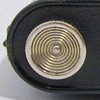 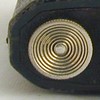
|
| Film flange of the Minolta Six and Semi Minolta. (Image rights) |
The camera exists in at least three versions:[2]
- f/5.6 lens, Crown C shutter, T, B, 25, 50, 100, 150 speeds;
- f/4.5 lens, Crown B shutter, T, B, 5, 10, 25, 50, 100, 200 speeds;
- f/4.5 lens, Crown S shutter, T, B, 5, 10, 25, 50, 100, 200 speeds, self-timer.
The lens is front-cell focusing and is called Coronar Anastigmat Nippon on all the models. It normally has 80mm focal length, and the aperture is set by an index at the bottom of the shutter plate. This lens was certainly made by Asahi Kōgaku, like the 75mm Coronar lenses of the Semi Minolta and Minolta Vest, and the serial numbers might run in the same sequence.[3]
The shutter is a version of the rim-set Crown in #0 size. It is everset and has a release lever and a distant release connector at the top left — as seen from the front. The shutter plate is marked PATENTS–NIPPON at the top, and has three metal stripes on each side of the lens. The three versions show subtle differences: the Crown C has two additional screws at the top right and at the bottom left; on the Crown C and Crown S, the aperture scale and the CROWN name are directly inscribed at the bottom of the shutter plate, whereas they are on a separate plate attached by two screws on the Crown B.
  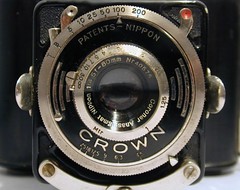
|
| From left to right: Coronar f/5.6 in Crown C, Coronar f/4.5 in Crown B and Coronar f/4.5 in Crown S with self-timer. Pictures courtesy of eBayer hbpartner. (Image rights) |
Commercial life
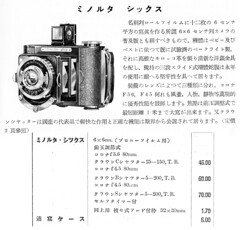
|
| Minolta Six in the July 1938 catalogue and price list by Asanuma Shōkai. Scan by A. Apra. (Image rights) |
The Minolta Six was released in late 1936 — Minolta's fifty-year history specifies November.[4] The earliest known advertisement is in the December issue of Asahi Camera.[5] It says that the camera is a new model and shows a sketch of the very first version with angled nameplate (see below), instead of a picture or detailed drawing. The three versions are mentioned (f/5.6, f/4.5, f/4.5 with self-timer) but the speed range is quoted as 25, 50, 100, 150, T, B in all cases, and no price is given. The camera was also featured the next month in the new products column of the same magazine.[6]
Advertisements dated 1937 to 1940 list the same three versions; the prices are ¥40, ¥53 and ¥60 in August 1937, and ¥46, ¥60 and ¥70 in January and July 1938 and in January 1940.[7] The pictures show a metal advance knob and a nameplate with rounded ends, but do not allow to tell the number of red windows or the exact shape of the advance knob. At least one advertisement or leaflet in English language is known;[8] it is not clear if this was published for foreign residents in Japan or for export.
The Minolta Six is mentioned for ¥75 in the list of set prices compiled in October 1940 and published in January 1941.[9] The camera is mentioned in the introduction of the October 1941 catalogue by Asanuma Shōkai, presenting the Minolta range and the lenses and shutters equipping the various models; however it does not appear in the main pages, and it was perhaps not available for sale any more.[10] The official price list dated November 1941 nonetheless has a "Minolta Six" and a "Minolta Six II", listed in the same price category with no further detail.[11]
Evolution
Three red windows
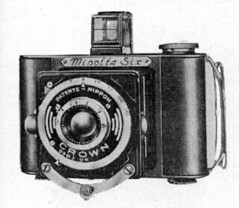
|
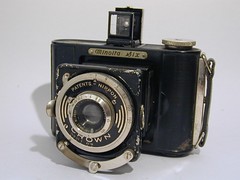 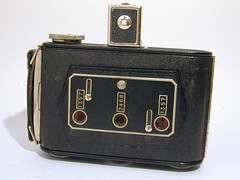
| |
| Minolta Six, early nameplate. From Shashin Kōgyō September 1958. (Image rights) |
Minolta Six no.3299, f/5.6 lens no.19913, three red windows. Pictures courtesy of eBayer hbpartner. (Image rights) | |
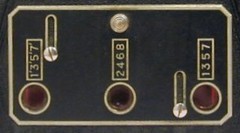
|
| Back plate with three red windows and winding indications. (Image rights) |
The original version has three red windows in the back, near the bottom. Each has a reminder, respectively reading 1357, 2468 and 1'3'5'7' from right to left, marked on a metal plate covering most part of the back. This complex advance pattern was needed because the paper backing of 120 film was not yet marked for 6×6cm format at the time the camera was introduced. The entire metal plate slides vertically and acts as a red window cover when in the down position.
 
|
| Metal knob, flat top and leather top. (Image rights) |
The very first examples have an angled nameplate, only observed so far with the f/5.6 lens.[12] This was soon substituted by a newer part with round edges and a different typeface. From that date, all three lens and shutter options are confirmed to exist.[13]
The early cameras also have an all-metal advance knob with a flat top, attached by a small off-centre screw. After some time, this was replaced by another metal knob with a recessed top, normally covered by a leather piece, which is often missing today.
Single red window
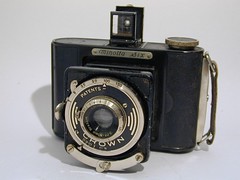 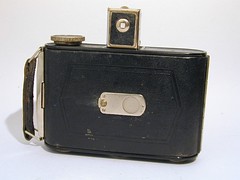 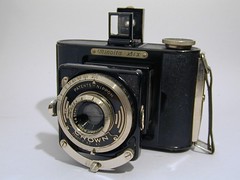
|
| Left and middle: Minolta Six no.13608, f/5.6 lens no.43405, single red window. Right: Minolta Six no.14781, f/4.5 lens no.82982, one red window. Pictures courtesy of eBayer hbpartner. (Image rights) |
The camera's back was modified at some point to have a single red window in the middle, protected by a horizontally sliding cover. This change occurred after the films were sold with 6×6 numbers, probably not later than 1937.
 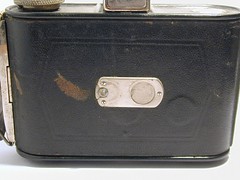
|
| Minolta Six no.11158, f/4.5 lens no.40575, self-timer, single red window. The three holes for the red windows are visible under the back leather. (Image rights) |
During a transitional period, the cameras were assembled with the older back part, transformed with a single red window. On various examples, such as the one pictured above, the holes for the three original red windows appear under the leatherette covering.[14]
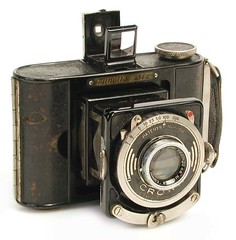 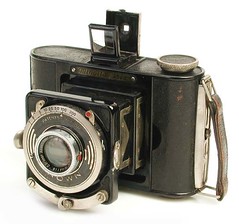 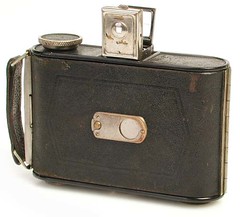
|
| Minolta Six no.14872, f/3.5 lens no.68719, self-timer, single red window. Pictures courtesy of Scott at www.collectiblecameras.com. (Image rights) |
The example pictured above has a Coronar Anastigmat Nippon 75mm f/3.5 lens in a Crown S shutter, but this equipment is probably not original, and the lens was probably taken from a Semi Minolta.
Bakelite knob
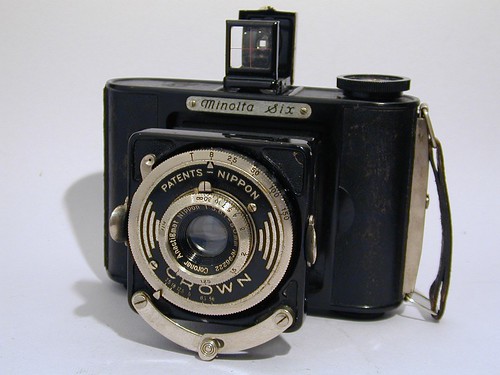
|
| Minolta Six no.19324, f/5.6 lens no.96222, bakelite knob. Picture courtesy of eBayer hbpartner. (Image rights) |

|
| Bakelite knob. (Image rights) |
The late Minolta Six have a bakelite advance knob. The metal knob is still visible in the January 1940 advertisement cited above, and the change probably occurred at a later date. Examples with a bakelite knob are known to exist with both lens types, but none has yet been observed with a self-timer.
Case and accessories

|
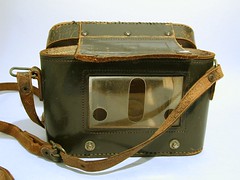
|
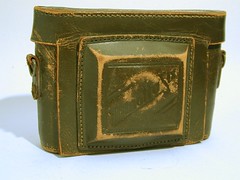
|

|
| Top: case for the Minolta Six, old type. Down: case for the Minolta Six, new type. Pictures courtesy of eBayer hbpartner. (Image rights) | |
At least two types of cases are known. They are embossed Minolta Six. The old type has a rectangular transparent window on the rear to show the back plate, whereas the new type has smaller openings for the single red window and its sliding cover.
The July 1938 catalogue by Asanuma Shōkai mentions the ever-ready case for ¥6 and a hood with filter holder for ¥1.70.[15]
Production
It is said that about 4–500 examples of the Minolta Six were produced per month in the Amagasaki plant.[16] The lowest reported body number is 3299 and the highest is 19324,[17] in a sequence which was probably specific to the Minolta Six. The known lens numbers run from 18928 to 98111, and the sequence was probably shared with other cameras having the Coronar lens. From the body numbers, the total production can be estimated at about 20,000 units, which is quite consistent with the monthly rate and four-year production run.
Notes
- ↑ Amagasaki plant: Awano, p.7 of Kurashikku Kamera Senka no.12.
- ↑ The Crown C, B, S shutter names are notably confirmed by the advertisement in Asahi Camera January 1938, reproduced in Tanimura, p.15 of Camera Collectors' News no.118.
- ↑ Coronar made by Asahi Kōgaku: "Kokusan shashinki no genjōchōsa" ("Inquiry into Japanese cameras"), items Lb5 and Lc9 (for the 75mm lenses of the Semi Minolta). This is also found in Sugiyama, p.27, and in Lewis, p.182.
- ↑ November: fifty-year history Minolta 50-nen no ayumi, pp.5 and 65; the same month is given in The Japanese Historical Camera. Many sources say that the camera was released in 1935: Francesch, p.78, Sugiyama, p.28, Scheibel, p.21, McKeown, p.673, Tanimura, p.1 of Camera Collectors' News no.116, and Awano, p.16 of Kurashikku Kamera Senka no.12, Eimukku 735 Minolta, pp.131 and 133. However the dating of other Molta cameras is known to contain mistakes (see for example Semi Minolta (I) and II).
- ↑ Advertisement reproduced in Kokusan kamera no rekishi, p.98. It is the earliest advertisement listed on p.342 of the same source.
- ↑ Kokusan kamera no rekishi, p.342.
- ↑ Advertisement in Asahi Camera August 1937 reproduced in Kokusan kamera no rekishi, p.97; advertisement in Asahi Camera January 1938 reproduced in Tanimura, p.15 of Camera Collectors' News no.118; price list by Asanuma Shōkai dated July 1938, p.2, reproduced in this page; advertisement in Shashin Shinpō January 1940 reproduced in Kokusan kamera no rekishi, p.98.
- ↑ Document reproduced in Francesch, p.22.
- ↑ "Kokusan shashinki no kōtei kakaku", type 4, section 1.
- ↑ Catalogue dated October 1941 by Asanuma Shōkai, pp.7–8.
- ↑ "Kamera no kōtei kakaku kanpō happyō", November 1941, type 4, section 1.
- ↑ Examples observed in online auctions.
- ↑ The version with self-timer and three red windows has not been directly observed, but is has been reported by a reliable source.
- ↑ Example no.11158 pictured in this page, and examples observed in online auctions.
- ↑ Price list by Asanuma Shōkai dated July 1938, p.2.
- ↑ Monthly rate: Tashima Gizō, interviewed by Saeki Kakugorō on p.78 of Kurashikku Kamera Senka no.12. Amagasaki plant: Awano, p.7 of the same magazine.
- ↑ Examples pictured in this page.
Bibliography
Original documents
- Asanuma Shōkai. Cameras — All other apparatus and materials — 1938. Catalogue dated July 1938, p.3, and corresponding price list, p.2. Documents partly reproduced in this Flickr album by Rebollo_fr.
- Asanuma Shōkai. Shashinki to zairyō (写真機と材料, Cameras and supplies). Catalogue dated October 1941, pp.7–8. Document partly reproduced in this Flickr album by Rebollo_fr.
- "Kamera no kōtei kakaku kanpō happyō" (カメラの公定価格官報発表, Official announcement of the set prices of the cameras), November 1941. Extract of a table listing Japanese camera production and setting the retail prices, reproduced in "Bebī Semi Fāsuto 'Kore ha bebī wo nanotta semi-ki da'" (ベビーセミファースト"これはベビーを名乗ったセミ機だ", Baby Semi First, 'this is a Semi camera called Baby'), an article by Furukawa Yasuo (古川保男) in Camera Collectors' News no. 277 (July 2000). Nishinomiya: Camera Collectors News-sha. P. 27. Type 4, section 1.
- "Kokusan shashinki no genjōchōsa" (国産写真機ノ現状調査, Inquiry into Japanese cameras), listing Japanese camera production as of April 1943. Reproduced in Supuringu kamera de ikou: Zen 69 kishu no shōkai to tsukaikata (スプリングカメラでいこう: 全69機種の紹介と使い方, Let's try spring cameras: Presentation and use of 69 machines). Tokyo: Shashinkogyo Syuppan-sha, 2004. ISBN 4-87956-072-3. Pp.180–7. This document does not mention the Minolta Six, but lists the Coronar lenses as made by Asahi Kōgaku.
- "Kokusan shashinki no kōtei kakaku" (国産写真機の公定価格, Set prices of the Japanese cameras), listing Japanese camera production as of October 25, 1940 and setting the retail prices from December 10, 1940. Published in Asahi Camera January 1941 and reproduced in Shōwa 10—40nen kōkoku ni miru kokusan kamera no rekishi (昭和10〜40年広告にみる国産カメラの歴史, Japanese camera history as seen in advertisements, 1935—1965). Tokyo: Asahi Shinbunsha, 1994. ISBN 4-02-330312-7. Pp.108—9. Type 4, section 1.
Official historical accounts
- Minolta Camera. Minolta 50-nen no ayumi (Minolta・50年のあゆみ, Minolta 50-year history). November 1978. Pp.5 and 65.
- Shashin Kōgyō no.77 (September 1958). "Hensen kamera ichiran-pyō" (変遷カメラ一らん表, Table of camera evolution.) P.295. (This is a chronology of Minolta cameras from the Nifcarette onwards. This document is reproduced in this Flickr page by Rebollo_fr.)
- Taniguchi Masao (谷口匡男), from the commercial department (営業部) of Chiyoda Kōgaku Seikō. "Minoruta kamera no sakujitsu, konnichi" (ミノルタ・カメラの昨日、今日, Minolta cameras, yesterday and today). In Shashin Kōgyō no.77 (September 1958). Pp.275–9. (The two first pages of this document, on pre-1937 cameras, are also reproduced in Tanimura, p.8 of Camera Collectors' News no.116.)
Recent sources
- Asahi Camera (アサヒカメラ) editorial staff. Shōwa 10–40nen kōkoku ni miru kokusan kamera no rekishi (昭和10–40年広告にみる国産カメラの歴史, Japanese camera history as seen in advertisements, 1935–1965). Tokyo: Asahi Shinbunsha, 1994. ISBN 4-02-330312-7. Item 278. (See also the advertisements for item 272.)
- Awano Mikio (粟野幹男). "Minoruta ryakushi" (ミノルタ略史, "Minolta short history"). Kamera Rebyū: Kurashikku Kamera Senka (カメラレビュー クラシックカメラ専科) / Camera Review: All about Historical Cameras no.12, October 1988. No ISBN number. Minoruta kamera no subete (ミノルタカメラのすべて, special issue on Minolta). Pp.6–8.
- Awano Mikio (粟野幹男). "Senzen no Minolta kamera" (戦前のミノルタカメラ, "Prewar Minolta cameras"). Kamera Rebyū: Kurashikku Kamera Senka (カメラレビュー クラシックカメラ専科) / Camera Review: All about Historical Cameras no.12, October 1988. No ISBN number. Minoruta kamera no subete (ミノルタカメラのすべて, special issue on Minolta). Pp.13–7.
- Christies auction catalogue: Scientific and Photographic Instruments and Books from the Estate of Dr. Samuel Koslov (18 November 1998), lot no.227.
- Eimukku 735, Manyuaru Kamera Shirīzu 15 (エイムック735・マニュアルカメラシリーズ15). Minolta: Minoruta kamera no subete (Minolta:ミノルタカメラのすべて, Minolta: all of Minolta cameras). Tokyo: Ei Shuppansha, 2003. ISBN 4-87099-923-4. "Jabara-shiki kamera no kiseki" (蛇腹式カメラの軌跡", Evolution of folding cameras). Pp.131 and 133. Shows a very small picture with a brief caption.
- Francesch, Dominique and Jean-Paul. Histoire de l'appareil photographique Minolta de 1929 à 1985. Paris: Dessain et Tolra, 1985. ISBN 2-249-27685-4. Pp.22 and 78.
- Lewis, Gordon, ed. The History of the Japanese Camera. Rochester, N.Y.: George Eastman House, International Museum of Photography & Film, 1991. ISBN 0-935398-17-1 (paper), 0-935398-16-3 (hard). Pp.53 and 182.
- McKeown, James M. and Joan C. McKeown's Price Guide to Antique and Classic Cameras, 12th Edition, 2005-2006. USA, Centennial Photo Service, 2004. ISBN 0-931838-40-1 (hardcover). ISBN 0-931838-41-X (softcover). P.673.
- Minolta: Minoruta kamera no subete (Minolta・ミノルタカメラのすべて, All of Minolta cameras). Eimukku no.735 (Manual Camera Series). ISBN 4-87099-923-4.
- Saeki Kakugorō (佐伯恪五郎). "Tashima Gizō-shi ni kiku" (田嶋義三氏に聞く, "Asking Tashima Gizō"). Kamera Rebyū: Kurashikku Kamera Senka (カメラレビュー クラシックカメラ専科) / Camera Review: All about Historical Cameras no.12, October 1988. No ISBN number. Minoruta kamera no subete (ミノルタカメラのすべて, special issue on Minolta). Pp.76–9.
- Scheibel, Anni Rita and Joseph. 70 Jahre Minolta Kameratechnik — Von der Nifcalette bis zur Dynax 9. Stuttgart: Lindemanns Verlag, 3rd edition, 1999. ISBN 3-89506-191-3. Pp.20–1.
- Sugiyama, Kōichi (杉山浩一); Naoi, Hiroaki (直井浩明); Bullock, John R. The Collector's Guide to Japanese Cameras. 国産カメラ図鑑 (Kokusan kamera zukan). Tokyo: Asahi Sonorama, 1985. ISBN 4-257-03187-5. Items 1193–4.
- Tanimura Yoshihiko (谷村吉彦). "Semi Minoruta I-gata to II-gata." (セミミノルタⅠ型とⅡ型, Semi Minolta I and II) In Camera Collectors' News no.116 (February 1987). Nishinomiya: Camera Collectors News-sha. (Contains a reproduction of the articles in Shashin Kōgyō no.77 and no other information on the Baby Minolta.)
- Tanimura Yoshihiko (谷村吉彦). "Semi Minoruta I-gata to II-gata (sono 2)." (セミミノルタⅠ型とⅡ型[その2], Semi Minolta I and II [part 2]) In Camera Collectors' News no.118 (April 1987). Nishinomiya: Camera Collectors News-sha. P.15: reproduction of an advertisement for the Minolta range published in Asahi Camera January 1938.
Links
In English:
- Minolta Six (f/5.6) in the 70th anniversary Minolta poster, reproduced at Photoclub Alpha
- Minolta Six (f/5.6) at Cameras Downunder
In Japanese:
- Minolta Six (f/4.5) in Ranzōsha's camera pages
- Minolta Six (f/5.6) at the AJCC
- Minolta Six (f/5.6) and more pictures in Miyazawa Noriyuki's camera site
- Minolta Six (f/4.5) in the Camera database of the Center of the History of Japanese Industrial Technology
- Minolta Six (f/5.6) in the Zeppan Tōsan photo site (incorporating this photograph). If the link does not work, go to the Zeppan Tōsan photo site, follow the link marked "武器庫" in the page menu, and then the link marked "ミノルタSIX" in the left menu
In German:
| Nifca, Molta and Chiyoda prewar and wartime cameras () | |
|---|---|
| folding plate cameras | |
| Nifcaklapp | Nifcasport | Sirius | Arcadia | Lomax | Eaton | Happy | |
| folding rollfilm cameras | telescopic bakelite cameras |
| Nifcarette | Sirius Bebe | Semi Minolta | Auto Semi Minolta | Minolta Vest | Baby Minolta | Minolta Six |
| strut-folding cameras | TLR cameras |
| Nifca-Dox | Minolta | Auto Minolta | Auto Press Minolta | Minoltaflex | Minoltaflex Automat | Minoltaflex military prototype |